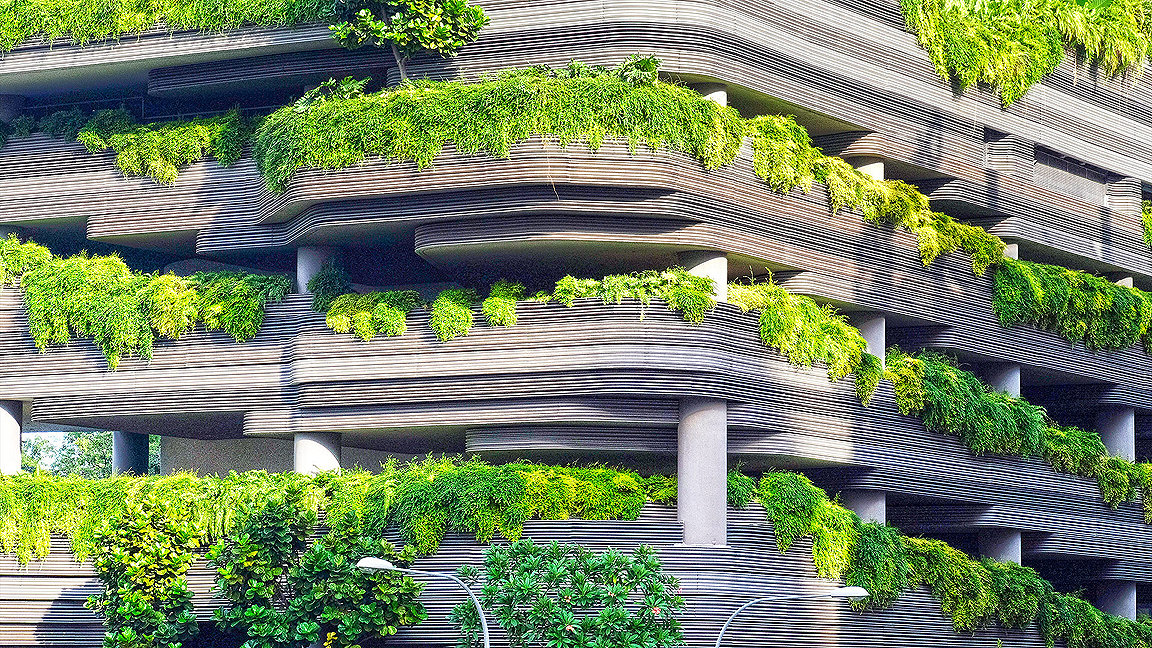
The ParkRoyal on Pickering hotel in Singapore
As the world emerges from the pandemic, an infrastructure-driven economic recovery appears more and more likely. Governments across the globe are launching infrastructure spending programmes and companies have put hitting CO2 reduction targets high on their agendas. In this three-part series, Modus speaks to leading female commercial real estate executives around the world about how property professionals can steer the conversation.
In part one, Helen Newman, senior director and head of sustainability at CBRE in the UK, talks about the urgent need to implement energy efficiency across the built environment, the effects of urbanisation, her company’s commitment to environmental, social and governance (ESG) principles, and the potential for circular economies that shift from the “take, make, dispose linear model.”
Global urbanisation. Urbanisation affects nearly every country in the world and more than half the world’s population. It increases pressure on all urban infrastructure and negatively affects both our health and the environment’s health, with these impacts being felt far wider than the urban areas themselves. One model that responds to the challenge presented by urban growth is the concept of circular cities, and the adoption of circular economy principles in our approach to urban planning, architecture, construction and how each of us works in support of a more sustainable built environment.
A circular economy moves away from the take, make, dispose linear model, and aims to retain materials in use at their highest value for as long as possible. Deploying the principles of circularity, also referred to as the CE hierarchy, will help reduce raw material scarcity and improve security, as well as reducing embodied carbon, which is another significant challenge for our sector. We need to see a fundamental shift in the value of natural capital. Meaning, choosing to adapt and extend the life of our existing buildings, and prioritising major refurbishments and low carbon extensions, in preference to new construction.
The UK’s climate change commitments to emissions reductions are compared to 1990 levels. However, in 2021, having seen one of the wettest and coldest Mays on record, followed by the early June mini-heatwave and now the ‘June monsoon’, we find ourselves closer to 2050 than 1991, and we are directly experiencing the effects of our changing climate.
For what remains of this decade, the global construction and real estate sector must prioritise wide-ranging energy efficiency measures both across existing assets as the focus for any retrofitting, and as the first principle for any new construction. Energy efficiency improvements have the potential, according the International Energy Agency (IEA), to create the largest contribution to global emissions reduction.
Energy efficiency not only mitigates against future climate change but will adapt homes and buildings to our changing climate, supporting resilience. There are robust approaches that can help our industry move forward. For example, adopting Passive House standards or EnerPHit for retrofits has multiple benefits including high standards of climate resilience and occupant comfort, as well as energy efficiency. Importantly, this approach is based on in-use performance, and is applicable to both domestic and non-domestic buildings.
The industry must collectively move to in-use performance to meet the necessary carbon reductions. We are applying the Better Building Partnership’s (BBP) Design for Performance initiative and using the NABERS UK rating (which stands for the National Australian Built Environment Rating System) to make commercial buildings more efficient, during both major refurbishments and new construction. We are assessing the NABERS performance of client portfolios and setting out a clear net zero carbon roadmap for enhancing the performance of their assets.
“A circular economy moves away from the take, make, dispose linear model, and aims to retain materials in use at their highest value for as long as possible.”
In support of our ESG commitments to being a net zero carbon business across our emissions by 2030, we have collected and are now benchmarking our in-use performance data. This will identify opportunities for improvement in how our UK office and managed portfolio performs in line with our Science Based Target (SBT) and net zero carbon commitments.
The in-use performance of our offices is also important for our ESG commitments related to the wellness of our employees, and this has been a key performance requirement of the refurbishment of our new HQ in London, Henrietta House. We are on track to achieve a WELL-certified Platinum rating and we are installing a range of smart tech, including internal environmental quality monitors. To inform decisions about the spaces we occupy, and to support our occupier clients with space selection, we have also developed a sustainability performance tool that ranks the performance of potential spaces against key environmental and social performance metrics.
We are also acknowledging the sustainability skills gap, which exists within real estate and have established an All Greens network to engage our employees (now over 500 members), as well as rolling out our ‘Stickerbook’ to gamify the learning of sustainability; two initiatives which saw us win the EDIE engagement award in 2021.
“We are directly experiencing the effects of our changing climate.”
The Public Services (Social Value Act) 2012 was a crucial piece of legislation for creating value through private-public partnerships beyond purely financial metrics. The act stimulated and elevated social value within the real estate sector outside purely private-public partnerships, with developers in particular, championing the creation of positive, local social impact through their development activities.
CBRE is applying social value more broadly within the sector, working to support investors with understanding the social value opportunities of their portfolios, and embedding this into real estate transactions.
Real estate portfolios managed under robust ESG strategies are generally giving better performance and investment returns. We are also seeing that sustainable buildings at the transactional phase are at less risk of a brown discount (when buildings that don’t meet market expectations are cheaper to rent/lease) and a write-down in value.
The last two years has seen a significant rise in the demand for ESG in real estate across our advisory business. This will continue to increase as mandatory disclosure requirements are introduced through the UK Green taxonomy (signalled to be similar to the EU Taxonomy), the Taskforce on Climate-related Financial Disclosures (TCFD) and operational energy rating and in-use reporting for commercial office and industrial space (over 1,000m2).
Helen Newman is head of sustainability and leads CBRE UK’s sustainability advisory services, specialising in developing and delivering ESG strategies, and embedding sustainability throughout the investment and property lifecycle.
Helen is also member of the CIBSE Knowledge panel and the ULI programme committee.

MODUS
TIna Paillet FRICS 02 April 2024
MODUS
Mark Williams 26 February 2024